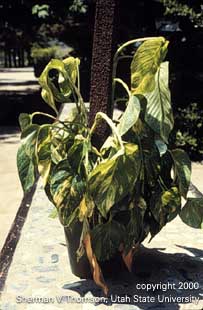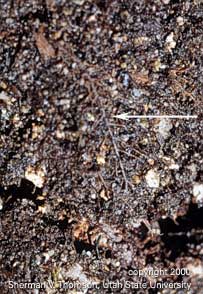Phytophthora Root & Crown Rot
 Philodendron infected with Phytophthora. Aerial portions of plants affected by this pathogen will show wilt symptoms due to the roots' incapability to transport water through their vascular system.
Philodendron infected with Phytophthora. Aerial portions of plants affected by this pathogen will show wilt symptoms due to the roots' incapability to transport water through their vascular system.
 Arrow indicates a African Violet root that was infected with Phytophthora and has since died due to the infection. Roots will be less vigorous and more susceptible to opportunistic pathogens when infected with Phytophthora.
Arrow indicates a African Violet root that was infected with Phytophthora and has since died due to the infection. Roots will be less vigorous and more susceptible to opportunistic pathogens when infected with Phytophthora.
SYMPTOMS
Phytophthora root and crown rot is a common problem on many of the bedding plants grown in Utah. Petunia, snapdragon, geranium and many other species are commonly infected. The problem is most often detected in beds that have been planted to the same species year after year. Once this fungus is introduced into flower beds, it is very difficult to grow petunias and snapdragons in the area. Consider using resistant plants such as marigold, verbena, salvia or ageratum.
Field diagnosis is possible with fair accuracy once the observer is familiar with the symptoms and the environmental factors favoring the disease. However, root and crown rot can be confused with several other diseases, such as Sclerotinia (white mold) or Rhizoctonia. However, when examined during the active stage of disease development, Sclerotinia and Rhizoctonia infections are usually accompanied with some mold growth over the surface of affected plant parts. Dig the plants and gently remove the soil from their roots for proper examination. Diagnosis can be confirmed by a plant disease diagnostic laboratory
CAUSE
Fungus: Phytophthora parasitica
The fungus is soil-borne, and the organism can survive in the soil indefinitely. There apparently is no practical resistance to the disease among petunia varieties. Some garden plants are seemingly unaffected by the disease organism.
CONTROL
Florists and bedding plant propagators should take all possible preventative steps to produce healthy plants. It can be spread via diseased plants and infested soil. Suspect plants should be discarded rather than sold, even at discount prices. Florists should steam soil, sterilize used containers, and follow all sanitation precautions consistent with good greenhouse operations. Fungicide drenches should be used routinely.
HOMEOWNER RECOMMENDATIONS
- Use disease-free plants. Don't use plants that show signs of disease with anticipation that the plants will improve. Chances are they will only decline further, and the disease will spread in the garden.
- Keep the garden soil as free of the disease organism as possible. Diseased plants and the soil around them should be carefully removed with a spade as soon as they are spotted. Such a procedure will not help where garden soils are severely infested, but it may benefit sites where diseased plants are infrequent.
- Improve soil drainage. Since the disease is especially associated with heavy clay soils, it may help to incorporate adequate amounts of soil amendments such as peat or sawdust.
- It is also important to raise flat planting areas so that the water will drain off rapidly and not saturate the soil. Irrigate deeply and infrequently. Allow the top 1/2 - 1 inch of soil to dry out before irrigating.
- Don't plant to deep. Set out the plants at the same depth as they were grown in the bedding flat.
- Use fungicides. Fungicide drenches have been helpful in controlling the disease where soil infestation by the fungus is not overwhelming.
No fungicide treatment should be attempted, however, unless the above mentioned cultural methods are also utilized. Otherwise, the results will be disappointing. Subdue (metalaxyl) is a systemic fungicide which is very effective in controlling Phytophthora diseases. It is used as a drench and works better as a regular preventative application. It is not yet labeled on all bedding plants so be sure to check the label and directions. Aliette (fosetyl-Al) is also effective against Phytophthora and is registered for use on a few woody ornamentals. Captan has been shown to be effective and Truban (and other ethazol-containing fungicides), and maneb have been reported to be helpful in some cases.
The most readily available compound for homeowner use is Captan. Drench soil thoroughly with 2 tablespoons/1 gallon water (this complies with label directions of 2 lbs captan/ 100 gallons of water) at planting. Repeat twice at 30-day intervals. It is best to apply the drench when the soil is reasonably dry so that the chemical penetrates the soil well.

